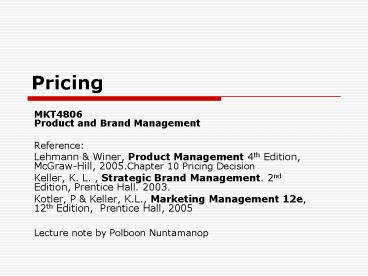Pricing - PowerPoint PPT Presentation
1 / 18
Title:
Pricing
Description:
High competition. Low or no growth of demand. Demand shifting ... BRAND to keep high perceived value. ... Keep high quality. Monitor quality and actual ... – PowerPoint PPT presentation
Number of Views:56
Avg rating:3.0/5.0
Title: Pricing
1
Pricing
- MKT4806 Product and Brand Management
- Reference
- Lehmann Winer, Product Management 4th Edition,
McGraw-Hill, 2005.Chapter 10 Pricing Decision - Keller, K. L. , Strategic Brand Management. 2nd
Edition, Prentice Hall. 2003. - Kotler, P Keller, K.L., Marketing Management
12e, 12th Edition, Prentice Hall, 2005
Lecture note by Polboon Nuntamanop
2
Concepts related to price and pricing
- Industrial product VS consumer products
- Economic Theory Demand Supply
- Perceived Value
- Product Life Cycle
- Cost, price Pricing structure
- Pricing strategy
3
Price perception
- Industrial products (raw materials)
- Costs to next steps production
- Saving to next steps production
- Overall cost of production
- Added-value to the end-product.
- Consumer products
- Perceived value of the product.
- Relative price compared to other substitutes.
4
How a customer considers about pricing when
buying a product?
- Compare Price and perceived value or the
benefits gained. - Compare price to a reference point, such as
price in the past or price of other products or
alternatives.
5
Influences on price decisions
- Psychological aspects
- Reference prices
- Price VS perceived quality and Perceived value
- Other emotional value.
- Pricing objectives
- Industry conditions
- Product Life Cycle
- Threat of new entrants
- Power of buyers ( choices)
- Competition situation
- Substitute products
- Capacity situation (Supply)
6
Economic TheoryDemand Supply
Price
Short-term
High
Supply
Optimum price
Costs
Demand
Quantity
0 1 2 3 4 .
High
Supply line At this price, producer is willing
to supply. Demand line At this price, buyer is
willing to buy.
7
Perceived Value
- ? The value of the product perceived by the
consumers. It can be lower or higher than actual
price. - Relations among perceived value, price and
variable cost - Perceived value gt price gt variable cost.
- Price gt Perceived value gt variable cost.
- Price gt variable cost gt perceived value.
8
Perceived value and price
- Perceived Value
- Reference points
- Variable costs
- Marginal costs
- Fixed costs
- Fixed operation costs
- RD costs
Perceived value A
Reference point
Profit
Variable costs
Fixed costs
(Include RD costs?)
9
Product Life Cycle
High competition Low or no growth of
demand Demand shifting / switching New
technology Product is outdated Etc.
What can happen?
Sales
High
Mature
Decline
Growth
Introduction
Low
Time
10
Costs Price structure
RD costs
Perceived value ??
PRCING
Total costs
Variable costs production, Part of selling
expenses, etc.
Other fixed / semi-fixed costs operation costs,
HR, Fixed selling, marketing costs.
RD costs Spread out for X years
11
Pricing Structure
Buyer Of finished products
Production
Operation
End users of The product
Wholesale
Retail
Price to users
Retail margin incentive to distribute
Wholesale margin incentive to distribute
Listed price to trade
Margin
Total costs
12
Pricing Objectives
- Price based on marketing objectives
- Maximum profit
- Market penetration
- Skimming (Prestige pricing)
- Quick profit (expect short product life cycle)
- Brand or Product positioning
- Customer value costs
- Return on investment
- Stability
13
Pricing Strategy
- Cost-plus pricing
- Perceived-value pricing
- Competitive pricing
- Multiple pricing
- Life-cycle pricing
- Auction
14
Pricing Tactics
- Product line pricing
- Bundling pricing
- Odd-ending pricing
- Volume discount incentive
- Promotion pricing (Value pricing)
- Complementary pricing ( fixed costs)
- Everyday low pricing
- Price Discrimination
- Hidden Price Increase
- Periodic discounts
15
Conclusions
- Perceived value which is closely related to brand
perception and perceived quality is the most
important key driver. - Factors to consider for price strategy decisions
- Perceived value of our products
- Costs to customers.
- Perceived value of competitive products
- Reference price points competitors, substitutes,
or other alternatives - Product life cycle.
- Total revenue ( price X volume) VS margin per
unit. - Long-term business stability
16
Product Pricing - Actions
- Build / strengthen BRAND to keep high perceived
value. - Be truthful about our products actual value to
users. - Keep high quality.
- Monitor quality and actual benefits to users.
- Monitor relative benefits to compare actual
values. - Aware of the product life cycle, replace new
products in time before the product lost its
momentum. - Keep brand positioning.
- Aim to total revenue and total profit (price
per unit X sales volume) rather than emphasizing
on unit profit rate.
17
Price settingPerceived value, Reference point
and price
- Price gt perceived value
- Price perceive value
- Price lt perceived value lt competitor
- Price lt Perceived value gt competitor
Perceived value ??
Reference point ??
Profit
Variable costs
Fixed costs
(Include RD costs)
D
A
B
C
NOTE gt Means more than, lt means less than
18
Price Setting
- Understand the trade structure of that particular
product - Understand costs.
- Understand expected product life cycle.
- Set price strategy.
- Decide distribution strategy for this particular
product. - Price setting, start with cost to users, the
price which the user has to pay. - Calculate retail trade margin. Should know
industrial expected retail trade margin for
products sold in the same shop. - Calculate expected wholesaler margin.
- Estimate price, calculate margin over x year.
- Set the price. (Listed Price)































